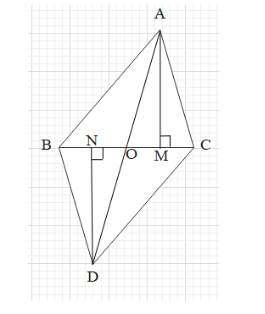
Answer
421.8k+ views
Hint: To prove that the side BC bisects AD, draw an appropriate figure that corresponds to the given data. Then prove that the two triangles have equal heights. Later, you can use congruence rules to prove the given statement.
Formula used:
$area(\Delta )=\dfrac{1}{2}\times base\times height$
Complete step-by-step answer:
The first thing to do in this type of question is to draw an appropriate figure with the help of the given data.
It is given that triangles ABC and DBC are on the same base BC and the vertices A and D are on the opposite sides of the side BC.
First, draw the line segment BC. Then taking BC as the common base, draw the two triangles up and down as shown.

The area of a triangle is equal to half of the product of its base and its height.
i.e. $area(\Delta )=\dfrac{1}{2}\times base\times height$.
Let the height of $\Delta ABC$ be AM and the height of $\Delta DBC$ be DN.
Therefore,
Area of $\left( \Delta ABC \right)=\dfrac{1}{2}\times BC\times AM$ … (i) and
Area of $\left( \Delta DBC \right)=\dfrac{1}{2}\times BC\times DN$ …. (ii)
But, we know that the area of $\left( \Delta ABC \right)=$ area of $\left( \Delta DBC \right)$.
Therefore, equate (i) and (ii).
$\Rightarrow \dfrac{1}{2}\times BC\times AM=\dfrac{1}{2}\times BC\times DN$
$\Rightarrow AM=DN$ …. (iii)..
Now consider $\Delta AMO$ and $\Delta DNO$.
Here, we just now proved that $AM=DN$.
Since height is perpendicular to the base, $\angle AMO=\angle DNO={{90}^{\circ }}$.
The angles AOM and DON are vertically opposite angles. This means that $\angle AOM=\angle DON$
Therefore,
$\Delta AMO\cong \Delta DNO$ by AAS congruence rule.
Now, since $\Delta AMO\cong \Delta DNO$, $AO=DO$.
But $AO+DO=AD$.
$\Rightarrow AO=DO=\dfrac{1}{2}AD$
This means that the side BC bisects AD.
Hence proved.
Note: In this question, we see that the two triangles having same base and equal area have equal heights. Hence, we proved another theorem that two triangles with the same base and equal area have equal heights.
This theorem is applicable even when the two triangles have equal bases but not common.
Formula used:
$area(\Delta )=\dfrac{1}{2}\times base\times height$
Complete step-by-step answer:
The first thing to do in this type of question is to draw an appropriate figure with the help of the given data.
It is given that triangles ABC and DBC are on the same base BC and the vertices A and D are on the opposite sides of the side BC.
First, draw the line segment BC. Then taking BC as the common base, draw the two triangles up and down as shown.

The area of a triangle is equal to half of the product of its base and its height.
i.e. $area(\Delta )=\dfrac{1}{2}\times base\times height$.
Let the height of $\Delta ABC$ be AM and the height of $\Delta DBC$ be DN.
Therefore,
Area of $\left( \Delta ABC \right)=\dfrac{1}{2}\times BC\times AM$ … (i) and
Area of $\left( \Delta DBC \right)=\dfrac{1}{2}\times BC\times DN$ …. (ii)
But, we know that the area of $\left( \Delta ABC \right)=$ area of $\left( \Delta DBC \right)$.
Therefore, equate (i) and (ii).
$\Rightarrow \dfrac{1}{2}\times BC\times AM=\dfrac{1}{2}\times BC\times DN$
$\Rightarrow AM=DN$ …. (iii)..
Now consider $\Delta AMO$ and $\Delta DNO$.
Here, we just now proved that $AM=DN$.
Since height is perpendicular to the base, $\angle AMO=\angle DNO={{90}^{\circ }}$.
The angles AOM and DON are vertically opposite angles. This means that $\angle AOM=\angle DON$
Therefore,
$\Delta AMO\cong \Delta DNO$ by AAS congruence rule.
Now, since $\Delta AMO\cong \Delta DNO$, $AO=DO$.
But $AO+DO=AD$.
$\Rightarrow AO=DO=\dfrac{1}{2}AD$
This means that the side BC bisects AD.
Hence proved.
Note: In this question, we see that the two triangles having same base and equal area have equal heights. Hence, we proved another theorem that two triangles with the same base and equal area have equal heights.
This theorem is applicable even when the two triangles have equal bases but not common.
Recently Updated Pages
How many sigma and pi bonds are present in HCequiv class 11 chemistry CBSE

Mark and label the given geoinformation on the outline class 11 social science CBSE

When people say No pun intended what does that mea class 8 english CBSE

Name the states which share their boundary with Indias class 9 social science CBSE

Give an account of the Northern Plains of India class 9 social science CBSE

Change the following sentences into negative and interrogative class 10 english CBSE

Trending doubts
Difference Between Plant Cell and Animal Cell

Difference between Prokaryotic cell and Eukaryotic class 11 biology CBSE

Fill the blanks with the suitable prepositions 1 The class 9 english CBSE

Differentiate between homogeneous and heterogeneous class 12 chemistry CBSE

Which are the Top 10 Largest Countries of the World?

One cusec is equal to how many liters class 8 maths CBSE

Give 10 examples for herbs , shrubs , climbers , creepers

The mountain range which stretches from Gujarat in class 10 social science CBSE

The Equation xxx + 2 is Satisfied when x is Equal to Class 10 Maths



